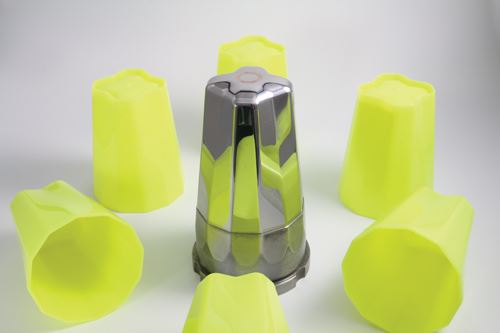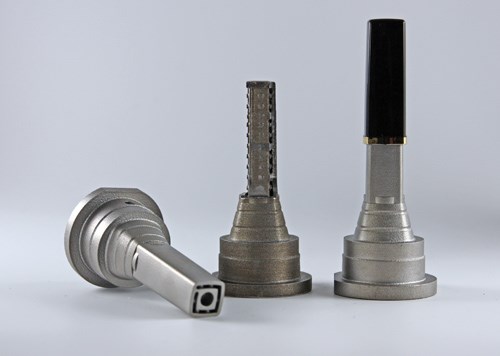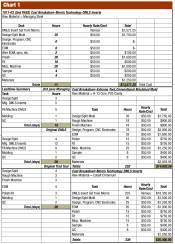Laser Sintering And Conformal Cooling Channels
Moldmakers who are interested in exploring conformal cooling, but are concerned about its complexity and expense need to understand two things: it is neither complex nor expensive.
The benefits conformal cooling offers, in terms of reduced cycle times and increased part quality, are enormous. Here is a thumbnail guide to what conformal cooling channels are, how to manufacture them easily and the rich rewards companies have reaped from them.
The Shape of Cooling
An engineer who designs a mold to be made by traditional processes is working with two goals constantly in mind: that it be optimally functional and readily manufacturable. Frequently, reaching the second goal involves compromising the first.
In satisfying cooling requirements, the mold designer-constrained by needing to drill straight channels-chooses routes that circulate the greatest amounts of fluid as close to the mold surface as possible. But in this case, even the best solution is seldom the ideal solution: straight channels don't always evenly cool curved surfaces in an efficient way. There can be potential hot spots, which can cause warped or distorted parts and also prolong cooling times. And since cooling times are a substantial portion of the molding cycle (up to 70 percent), those hot spots can seriously reduce production efficiency. That's why more and more moldmakers are taking a serious look at how to manufacture channels that conform to the surface of the mold and go where they are most needed. The method of choice-because it is simple and lets engineers tap into the full potential of design-driven manufacturing-is direct metal laser-sintering (DMLS).
DMLS Makes Design-Driven Manufacturing Easy
DMLS frees the moldmaker to dispense with manufacturability issues and focus solely on creating channels that follow the optimum cooling path, no matter how it twists and turns along the mold surface. Here's why: DMLS is an additive manufacturing process, not a cutting, drilling or grinding one. It builds parts from the bottom up, using data directly from a 3-D CAD model to guide the process. First the laser sintering system lays down a thin layer of powdered metal and melts a portion of it based on a cross-section taken from the model. It then spreads a layer on top of that one and sinters another cross-section, and another and so on, until the part is complete.
And except for surface finishing and a few other secondary operations, the part truly is complete. DMLS can grow a mold and its cooling channels at the same time, in one layer-by-layer operation. It's not always faster than traditional manufacturing, but it can eliminate the need for drilling, EDM and other finishing work. And most importantly, it opens new frontiers for design. When conventional manufacturing reaches its limits, conformal cooling or DMLS turns complexity into simplicity.
Because the channels are not bound by manufacturing restrictions, and because DMLS can build parts with incredibly complex geometries, there is almost no limit to the path of a channel or its shape. Some engineers opt for channels with elliptical cross-sections to get greater heat transfer near the mold surface. Others put in ribs at points where they want to induce turbulence, increasing the Reynolds number of the flow. Always, the drive for optimized cooling guides design decisions.
Channeling Success Stories
Millions of molded products are already being produced with conformal cooled molds and inserts that were manufactured using DMLS. Such cooling is becoming more common, but it is often a well-kept secret-a competitive edge-at plastics manufacturers. On the other hand, companies that are willing to talk about it often have a lot to brag about.
One successful project involved manufacturing a give-away hollow plastic golf ball. The manufacturer required large quantities of the balls at low costs. Production involved blow molding extruded polypropylene combined with the injection of an elastomer. The spherical shape meant that the part would cool unevenly with traditional straight cooling channels, promoting warpage and increasing scrap.
A laser sintered mold solved the problem. Conformal cooling channels extracted heat more evenly and efficiently. In addition, the mold incorporated tiny, efficient venting channels that would have been impossible to create by drilling. The finished four-cavity tool produced more than 20 million golf balls with a 20 percent increase in productivity.
Another example involved augmenting an existing tool for blow molding polyethylene bottles. In this instance, for the manufacturer the bottleneck literally was a bottleneck, because the neck required a thicker wall to withstand capping and stacking loads. It had substantially increased cooling times.
Adding a small conformally cooled insert to the tool resulted in much faster heat extraction, reducing cycle times from 15 to 9 seconds. On a four-bottle blow mold, the rapid cooling times made for a 75 percent increase in productivity with no drop in quality.
Results on another project were even more striking. A manufacturer was using a single-cavity injection mold to produce a high-quality children's cup. The company turned to conformal cooling to achieve two production goals: reduce cycle time and improve part quality-both while still retaining the original tooling. Our company worked with a toolmaker to create and laser sinter a maraging steel insert that removed heat much more efficiently and evenly. Not only was cycle time reduced by 40 percent, the insert provided optimal temperature distribution, keeping quality constant. The result, even for a single-cavity mold, was a staggering 70 percent total productivity increase.
Starting In
Exploring conformal cooling is simple and the steps involved are much like those of any tooling design project:
- Identify your mold cooling challenges. Is the cooling cycle longer than necessary? Are hot spots reducing part quality and increasing waste? How high is the production scrap rate?
- Share your challenges with an expert. A growing number of toolmaking suppliers have past experience that can streamline the design process for the channels. All that is needed to create the mold or insert is a CAD model of the plastic part and some non-proprietary information: what coolant is being used, what plastic molded, and what production volume required.
- Calculate and digitally simulate the solution. Primary concerns in designing conformal cooling channels are the same as for conventional conduits: the chemistry of plastics recrystalization and the physics of heat conductivity. As far as analyzing the efficiency of cooling, modeling a channel with a simple circular cross-section will provide a conservative safety-factor estimate of coolant flow and heat transfer.
- Test a physical prototype of the mold. Some companies contract with an experienced supplier for an initial production cycle. Others, who would rather rely on the familiarity of their own processes, purchase the mold and test it and the parts themselves.
More than 20 companies with a strong toolmaking component to their businesses have already purchased DMLS systems as part of their strategy to optimize production cycles, reduce scrap and increase product quality. Interest in conformal cooling channels-unlike the channels themselves-won't be cooling down any time soon.
Related Content
Four Micro Tooling Considerations
Issues involving gating, ejection, mold splits and direction of pull are of special concern when it comes to micro tooling.
Read MoreTolerancing in Mold Design, Part 2: Using GD&T to Address Conventional Tolerancing Issues
Mold designers can achieve a single interpretation of workpiece functionality when following the American Society of Mechanical Engineers Geometric Dimensioning and Tolerancing standard.
Read MoreIt Starts With the Part: A Plastic Part Checklist Ensures Good Mold Design
All successful mold build projects start with examining the part to be molded to ensure it is moldable and will meet the customers' production objectives.
Read MoreThree Good Reasons to Switch from Three- to Five-Axis Machining in Moldmaking
Five-axis machining technology is a great tool in the moldmaker toolbox.
Read MoreRead Next
Direct Metal Laser Sintering vs. Conventional Tool, Part Two
In this head-to-head comparison, conventional toolmaking seemed to be the superior route to go from a cost, quality and leadtime perspective.
Read MoreAre You a Moldmaker Considering 3D Printing? Consider the 3D Printing Workshop at NPE2024
Presentations will cover 3D printing for mold tooling, material innovation, product development, bridge production and full-scale, high-volume additive manufacturing.
Read MoreReasons to Use Fiber Lasers for Mold Cleaning
Fiber lasers offer a simplicity, speed, control and portability, minimizing mold cleaning risks.
Read More























